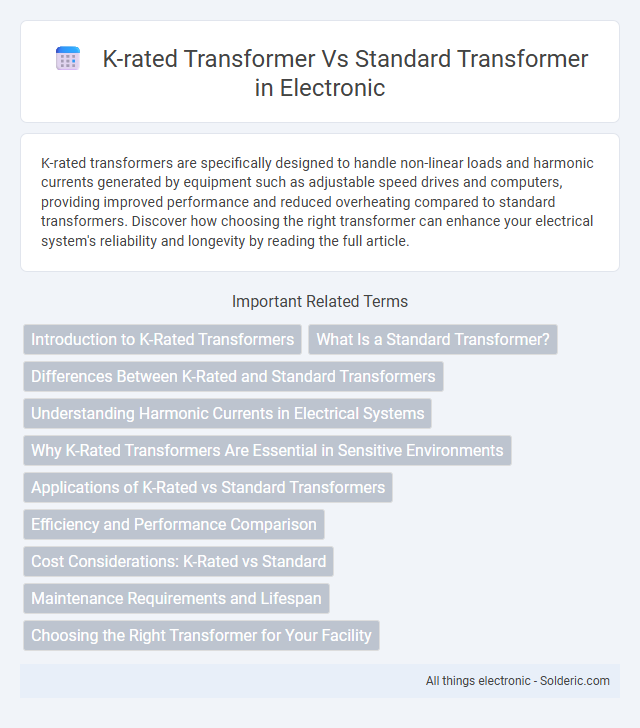K-rated transformers are specifically designed to handle non-linear loads and harmonic currents generated by equipment such as adjustable speed drives and computers, providing improved performance and reduced overheating compared to standard transformers. Discover how choosing the right transformer can enhance your electrical system's reliability and longevity by reading the full article.
Comparison Table
| Feature | K-Rated Transformer | Standard Transformer |
|---|---|---|
| Purpose | Designed to handle non-linear loads and harmonic currents | Designed mainly for linear loads with low harmonic distortion |
| Harmonic Handling | High tolerance for harmonic currents without overheating | Limited tolerance, prone to overheating under harmonic distortion |
| Core Construction | Specially designed core with higher-grade electrical steel | Standard core materials |
| Insulation | Enhanced insulation for increased thermal endurance | Standard insulation suitable for normal loads |
| Thermal Rating | Higher thermal rating to withstand harmonic heat losses | Rated for normal thermal losses |
| Applications | Industrial environments with variable frequency drives, UPS, and non-linear loads | General power distribution for linear load applications |
| Cost | Higher initial cost due to enhanced design | Lower initial cost |
| Efficiency | Maintains efficiency under harmonic stress | Efficiency drops with harmonic distortions |
Introduction to K-Rated Transformers
K-rated transformers are specially designed to handle non-linear loads generated by electronic equipment with harmonic currents, ensuring reliable operation without overheating. Unlike standard transformers, K-rated units feature enhanced thermal insulation and copper windings capable of withstanding increased harmonic distortion, typically characterized by a K-factor rating from 1 to 50. These transformers are essential in commercial and industrial environments with variable frequency drives, computers, and other electronics, maintaining efficiency and longevity under significant harmonic stress.
What Is a Standard Transformer?
A standard transformer is an electrical device that transfers electrical energy between two or more circuits through electromagnetic induction, typically designed for general applications with basic insulation ratings and efficiency levels. It operates at standard voltage and current specifications, serving common power distribution and industrial needs without specialized protection against elements like moisture or extreme temperatures. These transformers are widely used for stepping up or stepping down voltage in residential, commercial, and light industrial settings.
Differences Between K-Rated and Standard Transformers
K-rated transformers are specifically designed to handle non-linear loads that produce harmonic currents, such as computers and electronic equipment, unlike standard transformers which are suited for linear loads. The key difference lies in the K-factor rating, which quantifies a transformer's ability to withstand harmonic distortion without overheating or reduced lifespan. Your electrical system benefits from a K-rated transformer by ensuring reliable performance and longer service life in environments with significant harmonic content.
Understanding Harmonic Currents in Electrical Systems
K-rated transformers are specifically designed to handle harmonic currents generated by nonlinear loads, such as variable frequency drives and rectifiers, which cause excessive heating in standard transformers. These transformers feature improved insulation, increased copper losses capacity, and reinforced magnetic cores to withstand harmonic distortion without premature failure. Standard transformers, however, are optimized for linear loads and often suffer from overheating and reduced lifespan when exposed to significant harmonic currents.
Why K-Rated Transformers Are Essential in Sensitive Environments
K-rated transformers are essential in sensitive environments due to their ability to handle non-linear loads and prevent overheating caused by harmonic distortion, which standard transformers cannot effectively manage. They are specifically designed to support electronic equipment like computers, medical devices, and communication systems by maintaining voltage stability and reducing distortion. This increased resilience minimizes the risk of equipment failure and ensures continuous, reliable power in critical applications.
Applications of K-Rated vs Standard Transformers
K-rated transformers are designed to handle non-linear loads with harmonic currents, making them ideal for applications involving adjustable-speed drives, UPS systems, and data centers where electronic equipment produces distorted waveforms. Standard transformers are better suited for traditional linear loads such as lighting, heating, and motor loads with minimal harmonic distortion. Choosing a K-rated transformer ensures your electrical system maintains efficiency and prevents overheating when powering sensitive or electronic-heavy environments.
Efficiency and Performance Comparison
K-rated transformers offer superior efficiency compared to standard transformers, especially under non-linear load conditions commonly found in industrial environments. Your facility can benefit from reduced energy losses and improved voltage regulation, leading to enhanced overall performance and longer equipment lifespan. Standard transformers may experience overheating and decreased efficiency when subjected to harmonic distortion, whereas K-rated transformers are specifically designed to handle these challenges reliably.
Cost Considerations: K-Rated vs Standard
K-rated transformers are specifically designed to handle non-linear loads without overheating, making them more expensive than standard transformers due to enhanced insulation and cooling features. While standard transformers may have lower upfront costs, K-rated units offer better reliability and reduced maintenance expenses in environments with harmonic-rich loads like data centers or industrial facilities. Investing in a K-rated transformer can protect Your electrical system and potentially lower total cost of ownership in the long term.
Maintenance Requirements and Lifespan
K-rated transformers require less frequent maintenance due to their robust design, which effectively handles non-linear loads and minimizes overheating risks. Their enhanced thermal management and insulation systems contribute to a longer operational lifespan compared to standard transformers, which often experience accelerated wear under similar load conditions. Standard transformers typically demand more regular inspections and maintenance to prevent insulation degradation and premature failures in environments with significant harmonic distortion.
Choosing the Right Transformer for Your Facility
K-rated transformers are specifically designed to handle non-linear loads and harmonic distortions caused by equipment like variable frequency drives and computers, maintaining optimal performance and efficiency. Standard transformers are suitable for facilities with primarily linear loads and less electrical noise but may overheat or fail when subjected to harmonics. Choosing the right transformer for your facility ensures reliability, protects sensitive equipment, and avoids costly downtime associated with improper load handling.
K-rated transformer vs standard transformer Infographic

 solderic.com
solderic.com